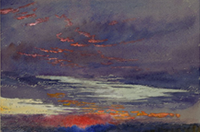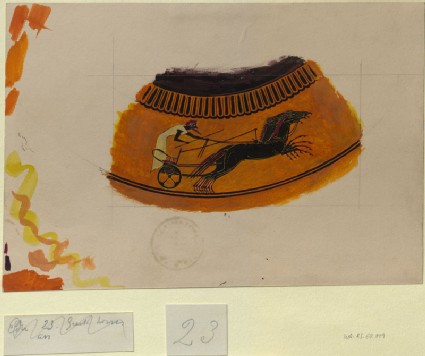Ruskin's Educational series, 2nd ed. (1874)
Ruskin's revised catalogue of 300 works for the instruction of undergraduates and his notes on the use of particular examples.

Ruskin's Catalogues: 1 object
Show search help- Reference URL
Actions
Drawing of a Chariot Race from a Greek Vase Arthur Burgess
-
Ruskin text
49. Chariot race.A careful drawing by Mr. Burgess, which will show you that all these engravings can be copied by pen and pencil, if you choose. But it is terribly difficult to leave the white lines, as in this drawing, between two delicate black ones, afterwards filling in the field with black. The white lines on the Greek vases are incised; and it will be good practice, if you are not skilled enough to leave them clear, to lay the black field first, and draw the white lines with body-white. But Mr. Burgess’s way is the only quite satisfactory one.
-
Details
- Artist/maker
-
Arthur Burgess (1843 - 1886)
- Object type
- drawing
- Material and technique
- watercolour, bodycolour and ink on pale brown wove paper
- Dimensions
- 176 x 258 mm
- Inscription
- Verso, bottom, right of centre: the Ruskin School's stamp
On a small, square, separate, paper label, in graphite: 23
On another small, rectangular, separate, paper label, in graphite, all struck through with a wavy line: Edu 23. Greek horses | an [?]
- Provenance
-
Presented by John Ruskin to the Ruskin Drawing School (University of Oxford), 1875; transferred from the Ruskin Drawing School to the Ashmolean Museum, c.1949.
- No. of items
- 1
- Accession no.
- WA.RS.ED.049
-
Subject terms allocated by curators:
Subjects
-
References in which this object is cited include:
References
Ruskin, John, Catalogue of the Educational Series (London: Smith, Elder, 1871), cat. Educational no. 24
Ruskin, John, Catalogue of the Educational Series (London: Spottiswoode, 1874), cat. Educational no. 49
Ruskin, John, Catalogue of Examples Arranged for Elementary Study in the University Galleries (Oxford: Clarendon Press, 1870), cat. Educational no. 23
Ruskin, John, ‘The Ruskin Art Collection at Oxford: Catalogues, Notes and Instructions’, Edward T. Cook and Alexander Wedderburn, eds, The Works of John Ruskin: Library Edition, 39 (London: George Allen, 1903-1912), 21, cat. Educational no. 49
Location
-
- currently in research collection
Position in Ruskin’s Collection
Ruskin's Catalogues
-
Ruskin's Educational series, 1st ed. (1871)
24 Chariot Race. Drawing from archaic vase. A -
Ruskin's Educational series, 2nd ed. (1874)
49. Chariot Race. Drawing from archaic Vase.A -
Ruskin's Catalogue of Examples (1870)
23. Chariot-race, from vase of finest time, of red clay, in the British Museum. No. 447* in Mr. Newton’s CatalogueCatalogue of the Greek and Etruscan Vases in the British Museum. (Nicol, Pall Mall, 1851.) It is highly desirable that you should possess this book, and if Mr. Newton will kindly see that every vase named in it retains its number, as described, painted in the vase in white on a black label, whatever future changes may be made in the arrangement of the collection, it will be of the utmost use for all purposes of study. .By Mr. Burgess, and carefully drawn, so that it may be a standard to you of good execution in the early vases. It is a little too difficult, however, for you to copy; the next is ruder and easier.





